Shōkaku-class aircraft carrier
 Shōkaku at Yokosuka, 8 August 1941, shortly after she was completed
| |
| Class overview | |
|---|---|
| Name | Shōkaku class |
| Builders | |
| Operators | |
| Preceded by | Hiryū |
| Succeeded by | Hiyō class |
| Built | 1938–1941 |
| In commission | 1941–1944 |
| Completed | 2 |
| Lost | 2 |
| General characteristics (as built) | |
| Type | Aircraft carrier |
| Displacement | 32,105 deep load ) |
| Length | 257.5 m (844 ft 10 in) |
| Beam | 29 m (95 ft 2 in) |
| Draft | 9.32 m (30 ft 7 in) (deep load) |
| Depth | 23 m (75 ft 6 in) |
| Installed power |
|
| Propulsion | 4 × shafts; 4 × Kampon geared steam turbines |
| Speed | 34.5 knots (63.9 km/h; 39.7 mph) |
| Range | 9,700 nmi (18,000 km; 11,200 mi) at 18 knots (33 km/h; 21 mph) |
| Complement | 1,660 |
| Armament |
|
| Armor |
|
| Aircraft carried |
|
The Shōkaku class (翔鶴型, Shōkaku-gata) consisted of two
Their inexperienced air groups were relegated to airfield attacks during the attack on Pearl Harbor, but they later sank two of the
For the next year, the sisters trained before moving south to defend against any American attempt to retake the
Background and description
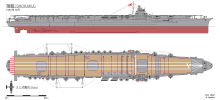
The two Shōkaku-class carriers were ordered in 1937 as part of the 3rd Naval Armaments Supplement Program. No longer restricted by the provisions of the Washington Naval Treaty, which had expired in December 1936, and with relaxed budgetary limitations, the IJN sought qualitative superiority over their foreign counterparts. Drawing on experience with their existing carriers, the Navy General Staff laid out an ambitious requirement for a ship that equaled the 96-aircraft capacity of the Akagi and Kaga, the speed of Hiryū and the defensive armament of Kaga. The new ship was also to have superior protection and range over any of the existing carriers.[2]
The Basic Design Section of the
The ships had a length of 257.5 meters (844 ft 10 in)
The Shōkaku-class ships were fitted with four
Flight deck and hangars
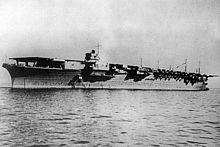
The carriers' 242.2-meter (794 ft 7 in) flight deck had a maximum width of 29 meters and overhung the
Aircraft were transported between the hangars and the flight deck by three elevators that took 15 seconds to go from the lower hangar to the flight deck. The forward elevator was larger than the others to allow aircraft that had just landed to be moved below without folding their wings and measured 13 by 16 meters (42 ft 8 in × 52 ft 6 in). The other elevators were narrower, 13 by 12 meters (42 ft 8 in × 39 ft 4 in).[8] The ships mounted a crane on the starboard side of the flight deck, abreast the rear elevator. When collapsed, it was flush with the flight deck.[9]
The Shōkaku-class carriers were initially intended to have an air group of 96, including 24 aircraft in reserve. These were envisioned as 12
Armament and sensors

The carriers' heavy
Their light AA armament consisted of a dozen triple-gun mounts for
In June 1942, Shōkaku and Zuikaku had their anti-aircraft armament augmented with six more triple 25 mm mounts, two each at the bow and stern, and one each fore and aft of the island. The bow and stern groups each received a Type 95 director. In October another triple 25 mm mount was added at the bow and stern and 10 single mounts were added before the Battle of the Philippine Sea in June 1944. After the battle, Zuikaku's anti-aircraft armament was reinforced with 26 single mounts for the 25 mm Type 96 gun, bringing the total of 25 mm barrels to 96, 60 in 20 triple mounts and 36 single mounts. These guns were supplemented by eight 28-round AA rocket launchers.[17] Each 12-centimeter (4.7 in) rocket weighed 22.5 kilograms (50 lb) and had a maximum velocity of 200 m/s (660 ft/s). Their maximum range was 4,800 meters (5,200 yd).[18]
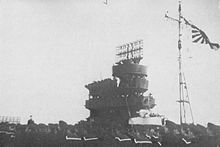
Shōkaku was the first carrier in the IJN to be fitted with
Protection
The Shōkaku class had a
The Shōkakus were the first Japanese carriers to incorporate a
Ships
| Name | Kanji | Builder[22] | Laid down[23]
|
Launched[22] | Completed[22] | Fate |
|---|---|---|---|---|---|---|
| Shōkaku | 翔鶴 | Yokosuka Naval Arsenal | 12 December 1937 | 1 June 1939 | 8 August 1941 | Torpedoed and sunk by USS Cavalla, 19 June 1944 |
| Zuikaku | 瑞鶴 | Kawasaki Kobe Shipyard | 25 May 1938 | 27 November 1939 | 25 September 1941 | Sunk by air attack during the Battle off Cape Engaño , 25 October 1944
|
Careers

Shortly after completion in 1941, Shōkaku and Zuikaku were assigned to the newly formed
In January 1942, together with Akagi and Kaga of the
Indian Ocean Raid
The sister ships then rejoined the Kido Butai at
Battle of the Coral Sea
En route to Japan, the Fifth Carrier Division was diverted to Truk to support Operation Mo (the planned capture of Port Moresby in New Guinea). While they were preparing for the mission, the Americans intercepted and decrypted Japanese naval messages discussing the operation and dispatched the carriers Yorktown and Lexington to stop the invasion. The Japanese opened Operation Mo by occupying Tulagi, in the Solomon Islands, on 3 May. American land-based aircraft had spotted the light carrier Shōhō escorting the transports of the main invasion force on 6 May, and the American carriers moved west to place themselves in a position to attack it the following morning.[35]
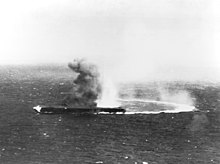
Shōhō was quickly located again that morning and sunk. In turn, the Japanese spotted the
On the morning of 8 May, both sides located each other at about the same time and began launching their aircraft about 09:00. The American dive bombers disabled Shōkaku's flight deck with three hits, but the carrier was able to evade all of the torpedoes. Hidden by a rain squall, Zuikaku escaped detection and was not attacked.[37] In return, the Japanese aircraft badly damaged Lexington with two torpedo and two bomb hits and scored a single bomb hit on Yorktown. The torpedo hits on Lexington cracked one of her avgas tanks, and leaking vapor caused a series of large explosions that caused her to be scuttled.[38]

The air groups of the sisters were decimated in the battle, which forced Zuikaku to return to Japan with Shōkaku for resupply and aircrew training, and neither carrier was able to take part in the Battle of Midway in June. En route to Japan, Shōkaku was caught in a severe storm and nearly capsized as the weight of the water used to put out the fires had compromised her stability. Repairs took three months and she was not ready for action until late August.[39]
Battle of the Eastern Solomons
The
Ryūjō and her escorts were the first Japanese ships spotted and sunk by the Americans later that morning, but Zuikaku and Shōkaku were not spotted until the afternoon.[43] Shortly before an unsuccessful attack by the pair of Douglas SBD Dauntlesses conducting the search, the sisters launched half of their dive bombers to attack the American carriers Enterprise and Saratoga. Most of the American carrier aircraft were already airborne by this time, either on CAP, returning from search missions, or from sinking Ryūjō, so only a small airstrike was launched in response to the spot report. About an hour after the first Japanese airstrike took off, a second airstrike that included the rest of the dive bombers was launched, but their target location was mistaken and they failed to find the Americans. The first airstrike attacked the two American carriers, scoring one hit on the battleship USS North Carolina and three hits on Enterprise, but they were mauled by the large number of airborne American aircraft and heavy anti-aircraft fire. Uncertain of the damage inflicted on each other, both sides disengaged later that evening.[44]
Battle of the Santa Cruz Islands
The First Carrier Division, now including the light carrier Zuihō, departed Truk on 11 October to support the Japanese Army operation to capture Henderson Field on Guadalcanal. At this time, the sisters mustered 54 A6Ms, 45 D3As, and 36 B5Ns between them. Four days later, the Japanese spotted a small American convoy that consisted of a fleet tug towing a gasoline barge and escorted by the destroyer Meredith. Aircraft from Shōkaku and Zuikaku sank the latter, but did not attack the tug.[45]
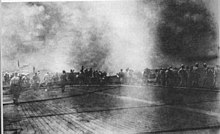
The Japanese and American carrier forces discovered each other in the early morning of 26 October and each side launched air strikes. Shōkaku was badly damaged by six hits from USS Hornet's dive bombers;[46] Zuikaku was not spotted or attacked as she was hidden by the overcast conditions, just like at the Battle of the Coral Sea. In exchange, the Japanese crippled Hornet with two torpedoes and three bombs. In addition, two aircraft crashed into the American carrier and inflicted serious damage. Enterprise was also damaged by two bomb hits and a near miss and a destroyer was damaged when it was struck by a B5N. Attacks later in the day further damaged Hornet, which was abandoned and later sunk by Japanese destroyers Makigumo and Akigumo. The Japanese lost nearly half their aircraft that participated in the battle, together with their irreplaceable experienced aircrew. On 2 November, the First Carrier Division was ordered home for repairs and training.[47]
Shōkaku's repairs continued until March 1943[48] and Zuikaku, together with the recently repaired Zuihō, sailed for Truk on 17 January to support the impending evacuation of Japanese ground forces from Guadalcanal (Operation Ke). On 29 January, the two carriers flew off 47 Zeros to Rabaul and Kahili Airfield, contributing some of their own aircraft and pilots. Zuihō was then used to cover the evacuation, while Zuikaku remained at Truk, together with the two Yamato-class battleships, acting as a fleet in being threatening to sortie at any time.[49]
In May, Shōkaku and Zuikaku were assigned to a mission to counterattack the
In February 1944, Shōkaku and Zuikaku were transferred to Singapore.[50] On 1 March the carrier divisions were reorganized with the new fleet carrier Taihō replacing Zuihō in the division.[52] The First Carrier Division sailed in mid-May for Tawi-Tawi in the Philippines.[50] The new base was closer to the oil wells in Borneo on which the IJN relied and also to the Palau and western Caroline Islands where the Japanese expected the next American attack; the location lacked an airfield on which to train the inexperienced pilots and American submarine activity restricted the ships to the anchorage.[53]
Battle of the Philippine Sea
The
The loss of Taihō and Shōkaku left Zuikaku to recover the Division's few remaining aircraft after their heavy losses (only 102 aircraft remained aboard the seven surviving carriers by the evening) and the 1st Mobile Fleet continued its withdrawal towards
Battle of Leyte Gulf

The American carriers launched an airstrike shortly after dawn; Zuikaku was struck by three bombs and one torpedo that started fires in both hangars, damaged one
Notes
- Hawaiian Standard Time, so in Japan, the attack on Pearl Harbor happened on 8 December.
Footnotes
- ^ Peattie, p. 243
- ^ a b Lengerer, p. 90
- ^ Lengerer, pp. 91, 93
- ^ Lengerer, pp. 93, 107
- ^ Lengerer, pp. 102–04, 106
- ^ Lengerer, pp. 93–95, 97–98
- ^ Dickson, pp. 18–19
- ^ Lengerer, p. 94
- ^ Dickson, p. 17
- ^ Lengerer, p. 109
- ^ Chesneau, p. 171
- ^ a b Brown 1977, p. 23
- ^ Campbell, pp. 192–93
- ^ a b Lengerer, p. 107
- ^ Stille 2007, p. 51
- ^ Campbell, p. 200
- ^ Lengerer, p. 105; Dickson, p. 25
- ^ Campbell, p. 216
- ^ Lengerer, pp. 101, 105; Dickson, pp. 27–28
- ^ Lengerer, p. 100
- ^ Lengerer, pp. 100–01, 107–08
- ^ a b c Jentschura, Jung & Mickel, p. 51
- ^ Lengerer, p. 93
- ^ a b Dickson, p. 28
- ^ Zimm, p. 101
- ^ Stille 2011, p. 25
- ^ Polmar & Genda, p. 173
- ^ Zimm, pp. 101, 215
- ^ Polmar & Genda, p. 186
- ^ Brown 2009, p. 124
- ^ a b Dickson, p. 31
- ^ Gill, p. 14
- ^ Shores, Cull & Izawa, Vol. II, pp. 395, 405
- ^ Shores, Cull & Izawa, Vol. II, pp. 413, 421–423, 426–429
- ^ Brown 2009, pp. 137–138
- ^ Lundstrom 2005a, pp. 192, 206–207, 209–217
- ^ Lundstrom 2005a, pp. 230–43
- ^ Stille 2009, pp. 85–86
- ^ Brown 2009, p. 143
- ^ Lundstrom 2005b, pp. 91–94
- ^ Brown 2009, p. 169
- ^ Lundstrom 2005b, p. 109
- ^ Brown 2009, pp. 170–171
- ^ Lundstrom 2005b, pp. 124–125, 136–141, 152, 156–157
- ^ Lundstrom 2005b, pp. 309–310
- ^ Brown 2009, pp. 181–183
- ^ Lundstrom 2005b, pp. 374, 391–407, 415–416, 447–450, 454
- ^ Tully, Shokaku
- ^ Letourneau & Letourneau, pp. 20, 24, 271–272
- ^ a b c d Tully, Shokaku and Zuikaku
- ^ Brown 2009, pp. 214–217
- ^ Brown 2009, pp. 227–228
- ^ Polmar & Genda, pp. 380–381
- ^ Brown 2009, pp. 255–257
- ^ Polmar & Genda, pp. 389, 393, 395
- ^ Tully, Parshall & Wolff
- ^ Brown 2009, pp. 262–265
- ^ a b c Tully, Zuikaku
- ^ Polmar & Genda, pp. 415, 420
- ^ Polmar & Genda, pp. 427–428
References
- Brown, David (1977). WWII Fact Files: Aircraft Carriers. New York: Arco Publishing. ISBN 0-668-04164-1.
- Brown, J. D. (2009). Carrier Operations in World War II. Annapolis, Maryland: Naval Institute Press. ISBN 978-1-59114-108-2.
- Campbell, John (1985). Naval Weapons of World War Two. Annapolis, Maryland: Naval Institute Press. ISBN 0-87021-459-4.
- Chesneau, Roger (1995). Aircraft Carriers of the World, 1914 to the Present: An Illustrated Encyclopedia (New, Revised ed.). Annapolis, Maryland: Naval Institute Press. ISBN 0-87021-902-2.
- Dickson, W. David (1977). "Fighting Flat-tops: The Shokakus". Warship International. XIV (1). Toledo, Ohio: International Naval Research Organization: 15–46. ISSN 0043-0374.
- Gill, G. Hermon (1968). Volume II – Royal Australian Navy, 1942–1945. OCLC 65475.
- Jentschura, Hansgeorg; Jung, Dieter & Mickel, Peter (1977). Warships of the Imperial Japanese Navy, 1869–1945. Annapolis, Maryland: United States Naval Institute. ISBN 0-87021-893-X.
- Lengerer, Hans (2014). "The Aircraft Carriers of the Shōkaku Class". In Jordan, John (ed.). Warship 2015. London: Conway. pp. 90–109. ISBN 978-1-84486-276-4.
- Letourneau, Robert & Letourneau, Dennis (2012). Operation KE: The Cactus Air Force and the Japanese Withdrawal From Guadalcanal. Annapolis, Maryland: Naval Institute Press. ISBN 978-1-61251-179-5.
- Lundstrom, John B. (2005a). The First Team: Pacific Naval Air Combat from Pearl Harbor to Midway (New ed.). Annapolis, Maryland: Naval Institute Press. ISBN 1-59114-471-X.
- Lundstrom, John B. (2005b). The First Team and the Guadalcanal Campaign. Annapolis, Maryland: Naval Institute Press. ISBN 1-55750-526-8.
- ISBN 1-55750-432-6.
- Polmar, Norman & ISBN 1-57488-663-0.
- Shores, Christopher; Cull, Brian & Izawa, Yasuho (1992). Bloody Shambles. Vol. I: The Drift to War to the Fall of Singapore. London: Grub Street. ISBN 0-948817-50-X.
- Shores, Christopher; Cull, Brian & Izawa, Yasuho (1993). Bloody Shambles. Vol. II: The Defence of Sumatra to the Fall of Burma. London: Grub Street. ISBN 0-948817-67-4.
- Stille, Mark (2009). The Coral Sea 1942: The First Carrier Battle. Campaign. Vol. 214. Oxford, UK: Osprey Publishing. ISBN 978-1-84908-106-1.
- Stille, Mark (2011). Tora! Tora! Tora:! Pearl Harbor 1941. Raid. Vol. 26. Oxford, UK: Osprey Publishing. ISBN 978-1-84908-509-0.
- Stille, Mark (2007). USN Carriers vs IJN Carriers: The Pacific 1942. Duel. Vol. 6. Oxford, UK: Osprey Publishing. ISBN 978-1-84603-248-6.
- Tully, Anthony P. (30 July 2010). "IJN Shokaku: Tabular Record of Movement". Kido Butai. Combinedfleet.com. Retrieved 14 July 2015.
- Tully, Anthony P. (September 2010). "IJN Zuikaku: Tabular Record of Movement". Kido Butai. Combinedfleet.com. Retrieved 14 July 2015.
- Tully, Anthony; Parshall, Jon & Wolff, Richard. "The Sinking of Shokaku – An Analysis". Kido Butai. Combinedfleet.com. Retrieved 26 July 2015.
- Zimm, Alan D. (2011). Attack on Pearl Harbor: Strategy, Combat, Myths, Deceptions. Havertown, Pennsylvania: Casemate Publishers. ISBN 978-1-61200-010-7.
